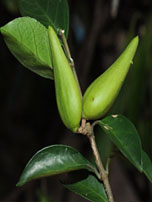SHAHEED KARTAR SINGH SARABHA AYURVEDIC MEDICAL COLLEGE & HOSPITAL
Affiliated to Guru Ravidas Ayurved University, Hoshiarpur Punjab
Affiliated to Guru Ravidas Ayurved University, Hoshiarpur Punjab

Botanical Name : Gymnema sylvestre B. Br.
Family : Asclepiadaceae
Introduction :
Latin name: Gymnema = gymnos = naked; sylvestree = sylva wood land.
Names in different Indian languages :
English : Australian Cow Plant, periploca of the woods
Hindi : Gudmar
Malayalam : Chakkarakkoli
Sanskrit : meshasrngi
Tamil : sakkarakkoli
Telgu : podapatra
Synonyms :
Meshashringi, madunashini , Meshavishaanikaa, Meshavalli, Chhaagalshrngi. Ajashringi
Morphology :
A herb bearing multiple branches and growing widely.
Leaves – 3 to 7 cms. long, oval, flowers – yellowish, in clusters.
Fruits – 4 to 6 cm. long, hard, arrow shaped.
One out of two legumes does not grow. Seeds – long, oval, flat, winged.
flowering occurs in autumn , fruiting in winter.
The tongue becomes insensitive to sweet and bitter tastes for 1 to 2 hours after chewing the leaves of meshashringi.
Distribution & Habitat :
Throughout India
Chemical constituents :
Gymnemic acids
Properties :
Guna : laghu, ruksha;
Rasa: kashaya:
Virya: ushna;
Vipaka: katu
Karma :
Chakusya, dipana, sramsanam, rechani
carminative, digestive, astingent,cooling, diuretic, antimicrobial, antifungal, anthelmintic, emetic, expectorant, astringent, stomachic., antipyretic, anti-inflammatory
Srotogamitva :
Dosha: Kaphaghna. vataghna.
Dhatu: Rakta (lowering blood sugar, liver stimulant). rasa (useful in amenorrhoea).
Mala: Mutra (lowers sugar, diabetes, calculus).
Indication :
Hridroga, kasa, swasa, meha, kusta
Diabetes, dysentery, gout, burning sensation, dyspepsia, cephalgia, worm infection
Part used :
Whole plant
Dosage :
Leaf juice 10-15 ml
Powder 2-4 g
Decoction 50-100 ml
External uses :
External use: Application of leaves mixed with castor oil is useful in glandular swelling, hepatitis and splenic entargement. Roots are used for application in snake bite.
Internal uses :
Its main action is seen on the digestive system as appetizer, astringent and a hepatic stimulant, it helps to maintain the blood sugar to 0.12% by acting on pancreas, adrenal glands and the digestive glands. Hepatic stimulation leads indirectly to secretion of insulin from pancreas. This reduces the blood sugar and also the urinary sugar. These actions are obtained by using the leaves only and not by using extracts. Root has emetic properties similar to ipecac. It is useful in cardiac failure.
administration of seeds or roots in the form of smoking are used to relieve common cold and breathlessness. It is very useful in diabetes and calculi. A dose of 1-2 gms. of leaf powder with honey or cows milk is given twice a day. It is useful in amenorrhoea, typhoid fever, general debility.
